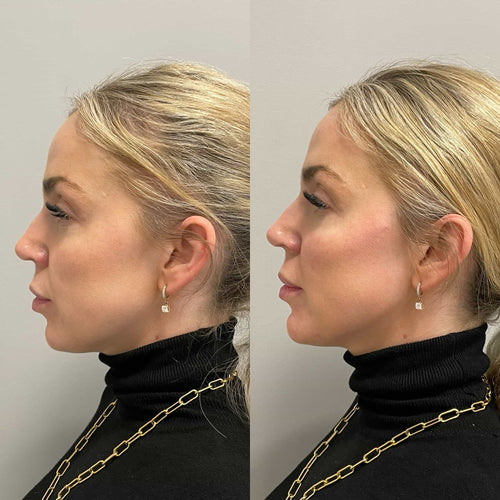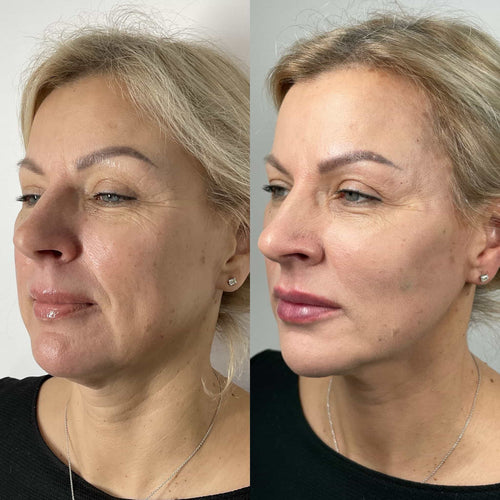Book a Dermal Filler Consultation with Dr. Laura Geige Today
Factors Affecting Jawline Filler Costs

Filler Type
Jawline filler costs can vary significantly based on several factors.
Arrange a Dermal Filler Session with Dr. Laura Geige Now
Here’s a breakdown of key considerations that influence pricing:
-
Geographic Location: Filler costs tend to be higher in metropolitan areas with a greater concentration of experienced practitioners and higher living expenses.
-
Practitioner Experience and Expertise: Highly sought-after injectors with extensive experience and a strong reputation often charge more due to their expertise and proven track record.
-
Filler Type and Quantity: Different dermal fillers are formulated with varying concentrations of hyaluronic acid, which impacts their longevity and effectiveness. Premium filler brands or those requiring larger volumes for desired results may contribute to a higher overall cost.
-
Treatment Area and Complexity: The size and shape of the jawline, as well as any additional treatments being performed (e.g., chin augmentation), can affect the amount of filler needed and ultimately the price.
-
Facility Fees: Some clinics or spas may include facility fees in their pricing structure, which covers administrative costs, sterilization procedures, and other overhead expenses.
Regarding filler type, hyaluronic acid-based fillers are the most common choice for jawline augmentation. These fillers come in various viscosities (thicknesses) to suit different desired outcomes:

*
Smooth Fillers: Designed for subtle enhancement and smoothing out fine lines.
-
Ideal for initial jawline definition or minor contouring.
*
Medium Viscosity Fillers: Offer a more substantial lift and definition, suitable for moderate jawline projection.
-
Provide noticeable contouring with a natural-looking result.
*
Cross-Linked Fillers:** Highly cohesive and long-lasting, best suited for achieving dramatic jawline definition or augmenting a weak chin.
-
Can provide extended results for up to 24 months or more.
The specific filler type recommended by your practitioner will depend on your individual anatomy, desired outcome, and budget considerations.
Location of Clinic
The cost of jawline fillers can vary significantly based on several factors. One major factor is the experience and reputation of the injector.
Highly sought-after injectors with extensive experience and a proven track record often charge higher fees due to their expertise and demand.
Another factor influencing cost is the type of filler used. Different brands and formulations have varying costs, with some premium options being more expensive than others.
The amount of filler needed also plays a role in determining the overall price. A more pronounced jawline enhancement may require a larger volume of filler, resulting in a higher cost.
Geographic location can impact prices as well. Clinics located in major metropolitan areas or high-cost-of-living regions tend to charge more compared to those in smaller towns or rural areas.
Furthermore, the clinic’s overhead costs, such as rent, utilities, and staffing, can contribute to price variations.
Special offers or package deals may be available that can reduce the overall cost. It’s always a good idea to consult with multiple clinics and obtain personalized quotes based on individual needs and desired outcomes.
Number of Syringes Needed
Jawline filler costs can vary widely depending on several factors, making it difficult to provide a definitive answer without specific details about an individual’s desired outcome and situation.
One of the primary cost drivers is the geographic location of the clinic or provider. Costs tend to be higher in major metropolitan areas compared to smaller towns or rural regions.
The experience and reputation of the injector also play a significant role. Highly sought-after practitioners with extensive experience and a proven track record often charge more due to their expertise and demand.
The amount of filler required to achieve the desired results will directly impact the overall cost. Each syringe typically contains a certain volume of filler, and multiple syringes may be necessary for more dramatic or significant enhancements.
The type of filler used can also affect the price. Different brands and formulations have varying costs associated with them. Some fillers are considered premium options and command higher prices due to their unique properties or longer-lasting effects.
Other factors that can influence jawline filler costs include the complexity of the treatment, any additional procedures performed at the same time (e.g., Botox), and potential follow-up appointments.
Determining the number of syringes needed for jawline enhancement depends on several individual factors. The size and shape of your jawbone, the desired level of contouring, and your current facial structure all play a role. It’s best to consult with a qualified injector who can assess your needs and recommend an appropriate volume.
They will take into account your aesthetic goals and create a personalized treatment plan that outlines the number of syringes estimated to be necessary to achieve the desired results.
Average Costs Across the US
National Averages
Understanding average costs for procedures like jawline fillers requires looking beyond simple national averages. Medical expenses vary dramatically across the US due to factors like location, provider experience, clinic overhead, and the specific type and amount of filler used.
National averages can offer a general idea, but it’s crucial to research costs in your specific region. For example, major metropolitan areas tend to have higher prices compared to smaller towns or rural areas.
Factors influencing jawline filler cost include:
-
Type of Filler: Hyaluronic acid fillers are common and generally less expensive than other types like calcium hydroxylapatite.
-
Volume Needed: More filler requires a higher cost.
-
Provider Expertise: Highly experienced injectors often charge more due to their skill and reputation.
-
Clinic Location and Overhead: Costs can vary based on rent, utilities, and staff salaries in different areas.
While a national average might suggest a price range, getting personalized quotes from several qualified practitioners in your area is essential for accurate cost estimation.
Regional Variations
It’s impossible to provide a definitive answer about the cost of jawline fillers without knowing specific details like the provider, location, amount of filler used, and individual patient needs. However, we can discuss average costs across the US and regional variations.
The price of dermal fillers, including those used for jawline augmentation, can vary widely.
Here’s a general idea of potential cost ranges:
-
National Average: $600-$1,500 per syringe
-
Urban Areas (e.g., New York City, Los Angeles): $800-$2,000+ per syringe
-
Rural Areas: $400-$1,000 per syringe
Several factors influence these price differences:
-
Geographic Location: Costs are generally higher in metropolitan areas with a higher cost of living.
-
Provider Experience and Reputation: More experienced and sought-after injectors often charge higher fees.
-
Type of Filler: Different brands and formulations of fillers have varying prices.
-
Amount of Filler Used: The number of syringes required to achieve desired results will directly impact the overall cost.
Remember, these are just estimates. It’s essential to consult with a qualified and experienced injector to get a personalized cost estimate based on your individual needs and goals.
Alternatives to Traditional Fillers
Facial Fat Grafting
Reserve Your Dermal Filler Consultation with Dr. Laura Geige
While jawline fillers offer a popular and relatively quick solution for contouring, they are not without their drawbacks, including cost and potential side effects. For individuals seeking more permanent solutions or exploring alternatives to traditional fillers, facial fat grafting presents an intriguing option.
Facial fat grafting, also known as autologous fat transfer, involves harvesting fat from a donor site on the body, typically the abdomen, thighs, or buttocks. This harvested fat is then processed and carefully injected into the desired areas of the face, including the jawline, to add volume, enhance definition, and create a more sculpted appearance.
Here’s why facial fat grafting is gaining traction as an alternative to traditional jawline fillers:
- Permanence:** Unlike hyaluronic acid fillers that gradually dissolve over time, fat grafting offers a potentially permanent solution. While some grafted fat may be reabsorbed, a significant portion often remains, resulting in long-lasting enhancements.
- Natural Appearance: Using your own fat provides a natural and harmonious blend with existing facial tissue, minimizing the risk of unnatural lumps or bumps that can sometimes occur with fillers.
- **Versatility:** Facial fat grafting is not limited to the jawline. It can be used to address various facial concerns, such as augmenting cheeks, restoring lost volume in the temples, and smoothing out wrinkles.
- Surgical Procedure:** Facial fat grafting typically involves a minor surgical procedure, requiring anesthesia and a recovery period.
- **Cost:** While the long-term benefits can be significant, facial fat grafting is generally more expensive than temporary filler injections.
It’s important to note that facial fat grafting, while promising, does carry its own set of considerations:
Kybella Injections
Beyond traditional hyaluronic acid fillers, several alternatives exist for contouring and enhancing the jawline.
Calcium hydroxylapatite (CaHA) fillers offer a more permanent solution compared to hyaluronic acid, lasting up to 18 months. They provide similar volumizing effects but are known for their smoother texture and less risk of swelling.
Poly-L-lactic acid (PLLA) is another long-lasting filler that stimulates collagen production, gradually shaping the jawline over several treatments. This option can provide a more natural-looking lift over time.
Sculptra Aesthetic utilizes PLLA as well and is specifically designed for facial contouring. It’s injected into deeper layers of the skin, enhancing volume and definition in the jawline area.
Kybella injections are an option for individuals seeking a more permanent reduction in fat under the chin (submental fat). Unlike fillers, Kybella destroys fat cells through deoxycholic acid, gradually dissolving the excess fat over time.
It’s important to note that while these alternatives offer different durations and mechanisms of action, they all come with potential risks and side effects. Consultation with a qualified plastic surgeon or dermatologist is crucial for determining the most suitable option based on individual needs and expectations.
The cost of these treatments varies widely depending on factors such as the type of filler or injection used, the amount required, and the geographic location.
- Who Should Not Get Under Eye Fillers? - November 4, 2025
- What Is Russian Lip Filler Technique - November 3, 2025
- Weed Drinks That Taste Like Real Cocktails - November 1, 2025
